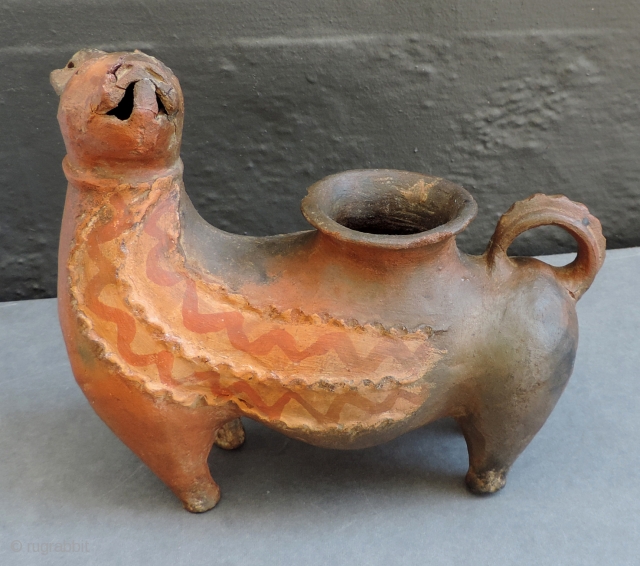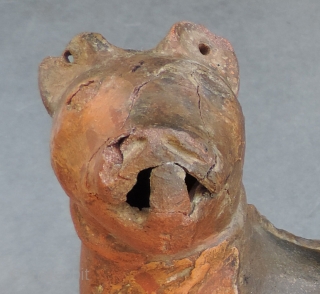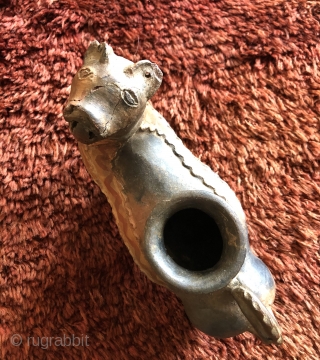Back
The large animal ceramic vessel pictured here presents a bit of a quandary as to its purpose and nature. It is unique among altiplano ceramics as far as i have seen and certainly fits into the category of ceremonial objects. It was possibly used in the Animal Increase Rite - a ceremony conducted by Aymara medicine men to bless the herds and bring them fertility and protection. But is this figure a lion or a llama? Most likely made as a libation vessel for holding ceremonial liquids, it is also possible it could be an incensario (incense burner) used two burn aromatic herbs and plants for the ceremony. Additionally, it is possible that it could have been made as a canopa - a vessel meant to hold ritual mixtures for ceremonial use. The figure might represent a lion – a mythical animal for the indigenous Aymara people that was introduced into the design lexicon after the arrival of the Spanish in the 1500's. There are depictions of lion-like creatures seen on certain Aymara feathered dance decorations. These were worn over the shoulders and were made up of river cane tubes covered with brilliant Amazonian parrot feathers worked in various designs. These often picture lion-like creatures with a colonial flavor. The bulbous shape of the body of this ceramic is not exactly llama or lion-like. The snout and tale features are ambiguous. The raised and painted decorations flowing from the head may represent a loin’s mane or a llama's long coat. Since it is unlikely that the maker of this vessel ever saw a lion in the flesh, this could help explain the distortion of the features to some degree. Interestingly, in the ancient Tiwanaku culture - to which the Aymara belonged, ceremonial incensarios are well known and were made in the shape of felines, llamas and condors. Pictured here is a drawing of a Tiwanaku incensario, supposedly representing a llama. Also seen here is an image of an ancient vessel that is remarkably similar in shape to the the piece posted here. The image is of a ceramic that dates back over 2000 years - continuity or coincidence - remarkable either way. If the ceramic vessel seen here had been used for drinking, the openings on the snout would allow for small streams of liquid to be poured out and/or to regulate air. But, if made as an incensario - to release plumes of smoke. As a canopa it would have held animal fat and other ritual ingredients. It is unclear how old this ceramic is, but it certainly dates to the 19th - if not the colonial period or before. If it depicts a llama, then the pre-Columbian period is not out of the question. The type of painted surface it shows is typical of ceramics found in the altiplano region that pre-date the Inca period. This figure once had earrings as seen by the ear holes. It has suffered breaks in its time to one ear, the snout area and tail. Because of the alien nature of the lion for Andean people, this animal may have been mythologized to some degree and its so its form distorted. Lion (feline) or Llama; that is the main question, age is secondary. Whatever this piece is, it is a very interesting work of folk art whose exact useage, age and depiction remain unknown - to me at least. Size: 8 x 7.75 x 4.5 inches.
price:
Inquire
- Home
- Antique Rugs by Region
- Category
- Profiles
- Post Items Free
- Albums
- Benaki Museum of Islamic Art
- Budapest: Ottoman Carpets
- Gulbenkian Museum
- Islamic Carpets. Brooklyn
- Islamic Textiles. Brooklyn
- Konya Museum: Rugs
- MKG, Hamburg
- MMA: Caucasian Carpets
- MMA: Mamluk Carpets
- MMA: Mughal Indian Carpets
- MMA: Ottoman Carpets
- MMA: Safavid Persian Carpets
- MMA: Turkmen Rugs
- McCoy Jones Kilims
- Ottoman textiles. Met
- Philadelphia Museum
- Rugs and Carpets: Berlin
- Seljuqs at the Met
- TIEM, Istanbul: Carpets
- V&A: Classical Carpets
- Vakiflar Carpets: Istanbul
- Baluch Rugs: Indianapolis
- Gallery Exhibitions
- Jaf an Exhibition
- Alberto Levi Gallery
- Andean Textile
- Christie's London: 2016
- Francesca Galloway
- HALI at 40
- ICOC Washington, DC 2018
- Jajims of the Shahsavan
- London Islamic Week April, 2018
- Mongolian Felts
- Navajo Rugs: JB Moore
- Persian Piled Weavings
- SF Tribal & Textile Art Show 2020
- SF Tribal 2019
- Sotheby's: C. Alexander
- Turkish Prayer Rugs
- Turkmen Main Carpets ICOC 2007
















